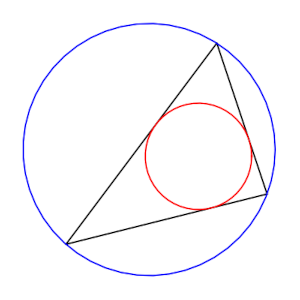Suppose you have a triangle and you know the size of the largest circle that can fit inside (the incircle) and the size of the smallest circle that can fit outside (the circumcircle). How would you estimate the perimeter of the triangle?
In terms of the figure below, if you know the circumference of the red and blue circles, how could you estimate the perimeter of the black triangle?

A crude estimate is that the triangle perimeter must be greater than the incircle circumference and less than the circumcircle circumference. But we can do better.
Gerretsen’s inequalities
It is conventional in this kind of problem to work with the semiperimeter of the triangle, half the perimeter, rather than the perimeter. Let r be the radius of the incircle, R the radius of the circumcircle, and s the semiperimeter of the triangle. Then Gerretsen’s inequalities say
16Rr − 5r² ≤ s² ≤ 4R² + 4Rr + 3r²
In the figure above,
r = 1.058, R = 2.5074, s = 6.1427
and Gerretsen’s inequalities give
36.8532 ≤ s² = 37.7327 ≤ 39.1200.
In the case of an equilateral triangle, Gerretsen’s inequalities are in fact equations.
Note that Gerretsen’s inequalities say nothing about the centers of the circles. An incircle must be inside a circumcircle, but for a variety of triangles with the centers of the two circles in different relations you have the same bounds.
Kooi’s inequality
Kooi’s inequality [2] gives another upper bound for the perimeter of the triangle:
s² ≤ ½ R(4R + r)² / (2R – r)
which in the example above gives a tighter upper bound, 38.9515.
Kooi’s upper bound is uniformly better than the upper bound half of Gerretsen’s inequalities. But further refinements are possible [3].
Related posts
[1] J. C. H. Gerretsen, Ongelijkheden in de driehoek. Nieuw Tijdschr 41 (1953), 1–7.
[2] O. Kooi, Inequalities for the triangle, Simon Stevin, 32 (1958), 97–101.
[3] Martin Lukarevski and Dan Stefan Marinescu. A refinement of the Kooi’s inequality, Mittenpunkt and applications. Journal of Mathematical Applications. Volume 13, Number 3 (2019), 827–832
The post Bounding the perimeter of a triangle between circles first appeared on John D. Cook.